A Chesapeake Crab Skiff for the Yankee-at-Heart
Burton Blais
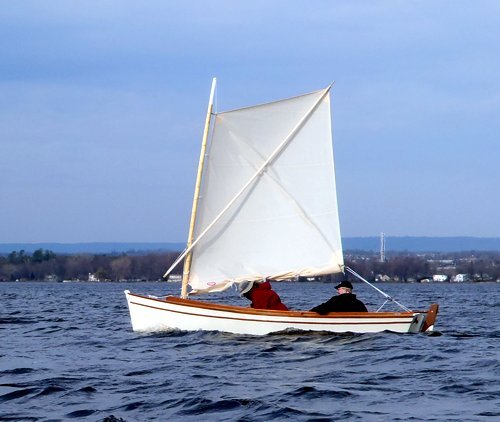
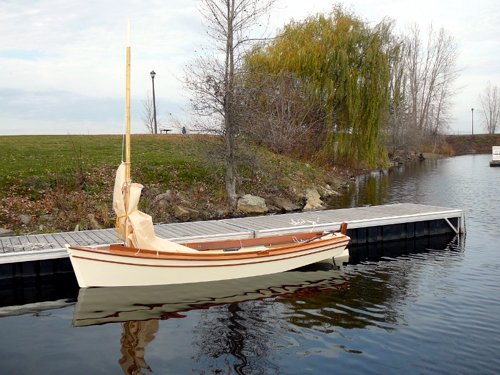
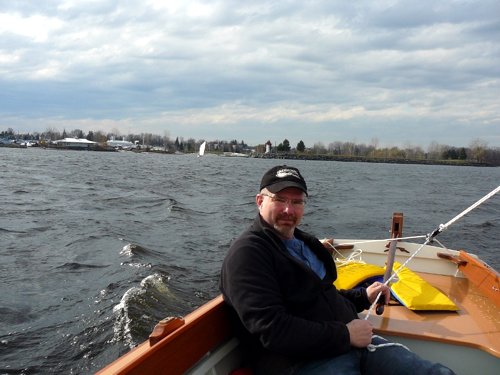
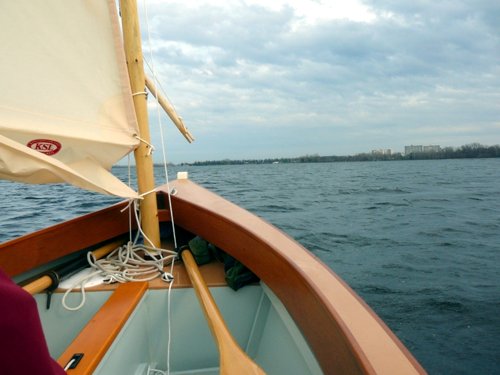
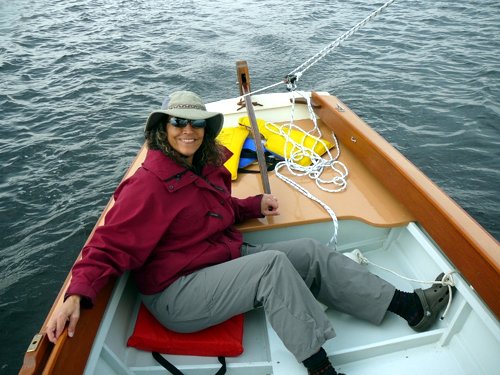
I am a latter-day boatman, seeking high adventure in small waters, navigating along the many and varied waterways with which we are particularly blessed in the northeastern part of the North American continent: pristine lakes and rivers, those great inland seas and maritime bays and estuaries, full of history and the promise of adventure, all ripe for re-discovery. Covering the ground in a self-sufficient manner is the art of the thing. What better conveyance to carry the ambition of such a Yankee outlook than an honest Yankee workboat?
She's a 15' LOA sprit-rigged sharpie of the type known as a Chesapeake crab skiff, designed by Doug Hylan, and she is to replace my old Sea Pearl 21 camp cruising standby. After many years of cruising in a variety of small craft, some self-built and others bought, I was seeking to expand my opportunities with a lightweight, rowable sailboat sporting a simple rig and which could be easily towed behind a modest family car while carrying two sea kayaks on the roof. In this manner, my wife and I could reach any horizon set upon by our imaginations while entertaining the broadest range of options for getting on the water. By all reports, the crab skiff is a very capable performer under sail and oars, a real load carrier which should be well suited to my camp cruising purposes.
A year in the making, she's built of mahogany marine ply (1/2" on the bottom with 3/8" sides), set on Douglas fir chines and keelson, with black walnut stem & apron, knees, centreboard case bed logs and a pine centre thwart, all held together with stainless steel fastenings and copious amounts of epoxy, and glassed on the outside for durability and ease of maintenance. This type of boat is fairly straightforward to build, and the plans give a sufficiency of detail to ensure a good product while giving an introduction to the use of a simple table of offsets from which to loft the frames. Getting out the transom was somewhat of a mystery, inexperienced as I am in the science of projection, though I did manage to get by with an empirical approach (i.e., follow the run of the chines aft of the last frame and fiddle with a hardboard template until it looks right). In fact, such hulls lend themselves rather well to empiricism. Deviations from the original design include the provision of sealed buoyancy chambers fore and aft (with the mast step in its own sealed box furnished with a drain hole in the bottom, a feature borrowed from Kiwi designer John Welsford), frames and floors for extra rigidity and a place for the splashes of water to settle, side decks and high coamings for comfort and security. She sports a crisp new sail made by Andy Soper of Kingston sail Loft – a true craftsman who understands traditional sails. Her mast is a spruce tree cut down from my property a few years back - very light, bendy but strong (despite a long spiral "check" which formed while seasoning in my shed), and a great concession to the old timers who likely used the same in their work skiffs. She has been named Jackrabbit (III), a moniker borne by all of my self-built (or re-built) camp cruisers, in honour of my personal hero of self-sufficiency, cross-country skiing legend Hermann "Jackrabbit" Johannsen.
She knew her first embrace of living waters on an unseasonably mild November day on the Ottawa River, and was quick to impress. Stepping down from the dock into the cockpit she stood up to my considerable bulk remarkably well despite her small proportions, attesting to the historic suitability of such hull forms as working platforms for the hard-worn inshore fishermen. Departing the small harbour under oars with the full main set, she soon found the wind and performed very well on all points, running and reaching with alacrity, even pointing as well as could be wished with the board down (tacking within 90 to100 degrees – quite sufficient to sail anywhere to windward). When the gusts came on we tied in a reef (not very difficult with this rig, which is provided with a halyard to lower the sail and bring down the centre of effort), and she sailed solidly on her feet even close hauled in a strong breeze. Her coamings and side decks kept a lot of spray out, and add to the comfort of sitting on the floor, back against the angled coaming with the tiller arm resting on the sternsheets. And she is handy to row, too. What more could one ask for? Only time and usage will tell.
There is still work to be done tuning that rig, achieving a better sheeting angle and tensioning the sprit, but re-learning to sail with every newly built design is all part of the grand adventure.
Now where did I put those charts of Georgian Bay…
Copyright © 2012 Burton Blais
Kemptville, Ontario
|